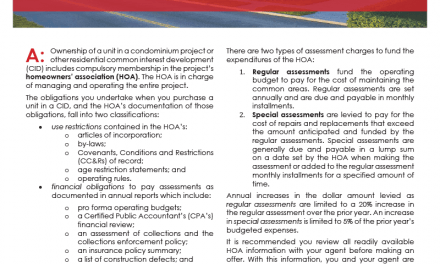What is a home inspection?
A home inspection is a non-invasive examination of the mechanical, electrical and plumbing systems of a dwelling. It also includes the components of the structure, such as the roof, ceiling, walls, floors and foundations.
Non-invasive indicates no intrusion into the roof, walls, foundation or soil by dismantling or taking apart the structure which would disturb components or cause repairs to be made to remove the effects of the intrusion. [Calif. Business and Professions Code §7195(a)(1)]The inspection of a one-to-four unit residential property is performed for a noncontingent fee.
The purpose of the physical examination of the premises is to identify material defects in the condition of the structure and its systems and components. Material defects are conditions which affect the property’s:
- market value;
- desirability as a dwelling;
- habitability from the elements; and
- safety from injury in its use as a dwelling.
Defects are material if they adversely affect the price a reasonably prudent and informed buyer would pay for the property when entering into a purchase agreement. As the report may affect value, the investigation and delivery of the home inspection report to a prospective buyer is legislated to precede a prospective buyer’s offer to purchase. [Bus & P C §7195(b)]
The home inspection report (HIR) is the written report prepared by the home inspector which sets forth the findings while conducting the physical examination of the property. The report identifies:
- each system and component of the structure inspected;
- describes any material defects the home inspector found or suspects;
- makes recommendations about the conditions observed; and
- suggests any further evaluation needed to be undertaken by other experts.
A home inspector’s qualifications
Any individual who holds themselves out as being in the business of conducting a home inspection and preparing a home inspection report on a one-to-four unit residential property is a home inspector. No licensing scheme exists to set the minimum standard of competency or qualifications necessary to enter the home inspection profession. [Bus & P C §7195(d)]
However, some real estate service providers typically conduct home inspections, such as:
- general contractors;
- structural pest control operators;
- architects; and
- registered engineers.
Home inspectors occasionally do not hold any type of license relating to construction, such as a person who is a construction worker or building department employee. However, they are required to conduct an inspection of a property with the same “degree of care” a reasonably prudent home inspector would exercise to locate material defects during their physical examination of the property and report their findings. [Bus & P C §7196]
Hiring a home inspector
Sellers and seller’s agents are encouraged by legislative policy to obtain and rely on the content of an HIR to prepare their mandated Transfer Disclosure Statement (TDS) for delivery to prospective buyers.
The buyer’s reliance on an HIR at the time a purchase agreement is entered into relieves the seller and their agent of any liability for property defects they did not know about or were not observable during the mandatory visual inspection conducted by the seller’s agent.
However, for the seller’s agent to avoid liability in the preparation the TDS by relying on an HIR, the seller’s agent needs to select a competent home inspector to inspect and prepare the HIR. Thus, the seller’s agent needs to exercise ordinary care when selecting the home inspector.
The Authorization to Inspect and Prepare a Home Inspection Report published by Realty Publications, Inc. (RPI) is used to document an agent’s request for an inspection. It authorizes the selected home inspector to conduct an inspection and prepare an HIR on behalf of the principal. [See RPI Form 130]
The Authorization to Inspect and Prepare a Home Inspection gives the home inspector specific information regarding the requested inspection, including:
- the property address [See RPI Form 1301];
- the type of property being inspected [See RPI Form 1301.1];
- the seller’s name and phone number [See RPI Form 1302];
- the contracting party requesting the HIR (whether the seller, buyer or agent) [See RPI Form 1304];
- contact information for the person to set up the inspection with [See RPI Form 1305];
- a confirmation whether the agent will be present or not at the inspection [See RPI Form 1305.1]; and
- the anticipated fee to be paid upon the delivery of the HIR to the agent. [See RPI Form 1307]
The form also includes instructions to the inspector that the HIR is to include:
- any improvements that are not in compliance with building codes and for which no permits exist [See RPI Form 1306.2]; and
- the property’s compliance with safety codes for child resistant pool barriers, hot tub covers, automatic garage doors, door locks/latches, gas valves, security bars and water heaters [See RPI Form 130 §6.3];
- an energy efficiency inspection. [See RPI Form 1306.1]
Related article:
Definition from CAG
Home inspection – A non-invasive examination of the mechanical, electrical and plumbing systems of a dwelling, as well as the components of the structure, such as the roof, ceiling, walls, floors and foundations.
[1] The inspection of a one-to-four unit residential property is performed for a noncontingent fee. [2] The home inspection report is the written report prepared by the home inspector which sets forth the findings while conducting the physical examination of the property. [3] The report identifies each system and component of the structure inspected, describes any material defects the home inspector found or suspects, makes recommendations about the conditions observed and suggests any further evaluation needed to be undertaken by other experts.













